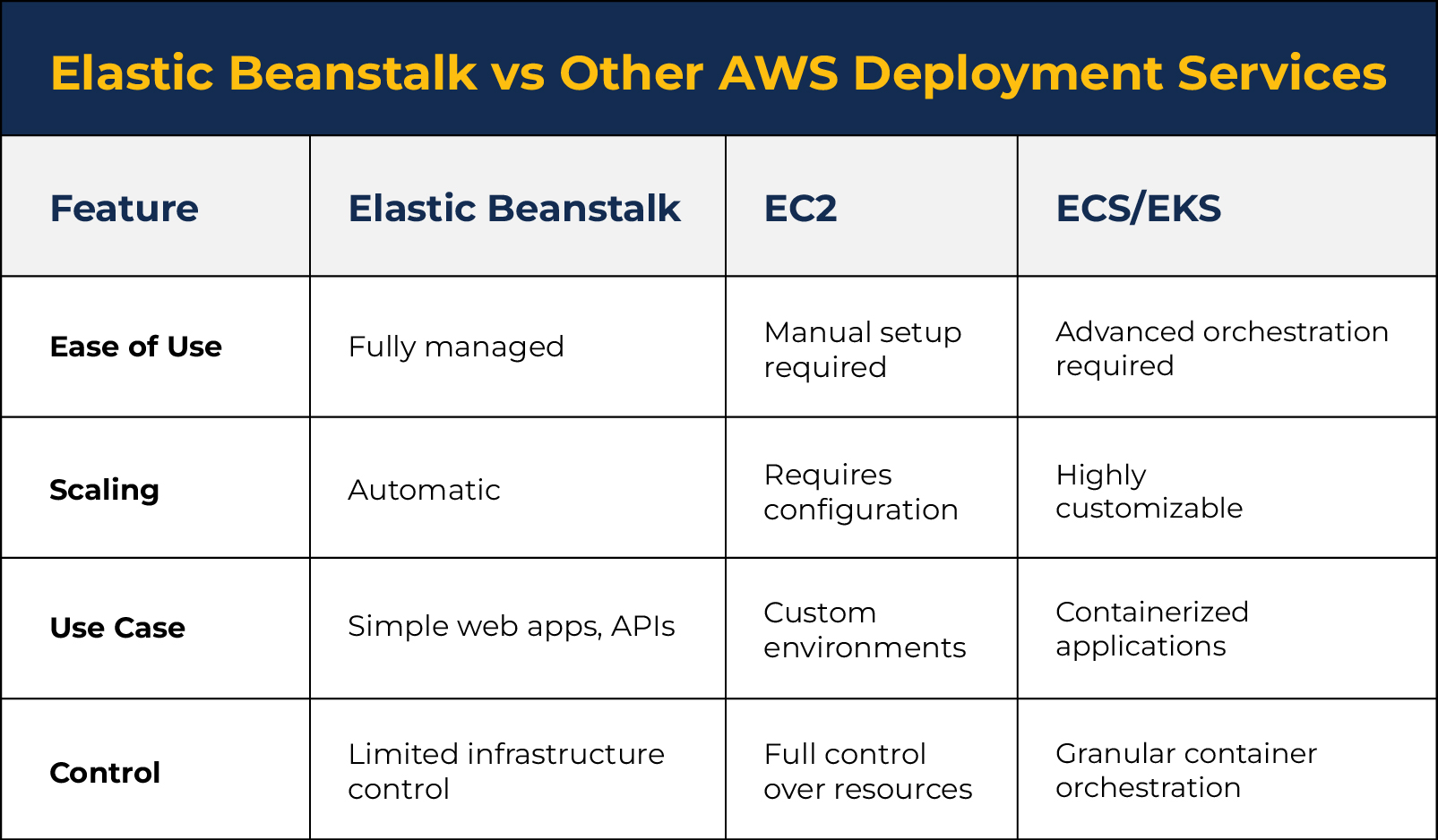
Deploying and managing applications can be a complex and time-consuming task, involving infrastructure setup, configuration, monitoring, and scaling.
AWS Elastic Beanstalk simplifies this process by offering a fully managed service that automates the deployment and scaling of cross platform app development and services.
This blog will explore how Elastic Beanstalk works, its benefits, and a step-by-step guide to deploying your first application.
What is AWS Elastic Beanstalk?
AWS Elastic Beanstalk is a Platform as a Service (PaaS) solution that enables developers to deploy and manage applications in the AWS cloud without worrying about the underlying infrastructure.
It supports various programming languages and frameworks, including:
- Java
- .NET
- js
- Python
- Ruby
- Go
- PHP
With Elastic Beanstalk, you simply upload your application code, and the service handles the rest: provisioning resources, load balancing, scaling, monitoring, and health checks.
Key Features of Elastic Beanstalk
- Simplified Deployment: Quickly deploy applications without managing servers or configurations.
- Automatic Scaling: Elastic Beanstalk automatically adjusts the number of instances based on traffic.
- Monitoring and Logging: Integrated with CloudWatch for performance monitoring and log access.
- Customizability: Customize the environment by uploading configuration files or integrating with other AWS services.
- Multi-Environment Support: Easily manage multiple environments (e.g., cross platform app development, staging, production).
Benefits of Using Elastic Beanstalk
- Ease of Use: Simplifies the deployment process, allowing developers to focus on writing code.
- Cost-Effective: Pay only for the AWS resources your application consumes.
- Flexibility: Choose your preferred language, framework, and deployment model.
- Scalability: Automatically scales your application to handle increased traffic.
- Integrated Management: Monitor and manage applications via the AWS Management Console, CLI, or APIs.
Use Cases of Elastic Beanstalk
- Web Application Hosting: Host and run web applications without the need to configure servers.
- Continuous Integration/Continuous Deployment (CI/CD): Integrate with pipelines smoothly for streamlined cross platform app development and deployment processes.
- E-commerce Platforms: Scale your online shop to handle variable traffic loads.
- API Hosting: Host RESTful APIs with fault tolerance and high availability.
- MVP Development: Rapidly deploy minimum viable products (MVPs) to gauge market readiness.

Prerequisites
Before deploying an application with Elastic Beanstalk, ensure you have the following:
- An AWS account.
- AWS CLI installed and configured.
- A basic understanding of your application’s code and framework.
Getting Started with Elastic Beanstalk
Step 1: Prepare Your Application
- Package your application files according to your language or framework requirements. For example, a Python application would typically have a requirements.txt file and a main application file such as app.py.
- Ensure your application runs locally before deploying it to Elastic Beanstalk.
Step 2: Create an Elastic Beanstalk Application
- Log in to the AWS Management Console.
- Navigate to Elastic Beanstalk.
- Click Create Application.
- Provide a name for your application (e.g., MyFirstApp).
- Select the platform that matches your application (e.g., Node.js, Python, etc.).
- Upload your application code as a ZIP file.
- Click Create Application.
Elastic Beanstalk will automatically provision the necessary resources, including EC2 instances, load balancers, and a default security group.
Step 3: Configure Your Environment
- Once your application is deployed, you can configure the environment to suit your needs:
- Scaling: Adjust the auto-scaling settings to handle varying levels of traffic.
- Environment Variables: Add key-value pairs to configure your application.
- Instance Types: Select the appropriate EC2 instance type for performance and cost optimization.
2. Click Save to apply your changes.
Step 4: Monitor and Manage Your Application
Elastic Beanstalk integrates seamlessly with CloudWatch, enabling you to monitor:
Access these metrics through the Elastic Beanstalk dashboard or CloudWatch console.
Step 5: Update Your Application
To deploy new versions of your application:
- Navigate to your application in the Elastic Beanstalk console.
- Click Upload and Deploy.
- Select your updated ZIP file and deploy it.
Elastic Beanstalk handles the update process, ensuring minimal downtime.
Security Considerations
- IAM Roles: Ensure that only necessary permissions are granted to Elastic Beanstalk resources.
- HTTPS: Configure your environment to serve traffic over HTTPS.
- Backup and Recovery: Regularly back up your data and configurations.
Conclusion
AWS Elastic Beanstalk is a powerful tool that simplifies application deployment and management, making it ideal for developers who want to focus on building features rather than managing infrastructure.
By following this guide, you can quickly deploy and manage scalable, secure, and reliable applications. Whether you’re a seasoned developer of cross platform app development or just starting, Elastic Beanstalk can streamline your deployment workflow.
If you need further help, you can contact us at [email protected]. We will schedule a free consultation session to explore how Xavor can assist you in this matter.
https://www.xavor.com/wp-content/uploads/2025/02/Simplify-Cross-Platform-App-Development-with-AWS-Elastic-Beanstalk-01.jpg
2025-02-20 02:07:17